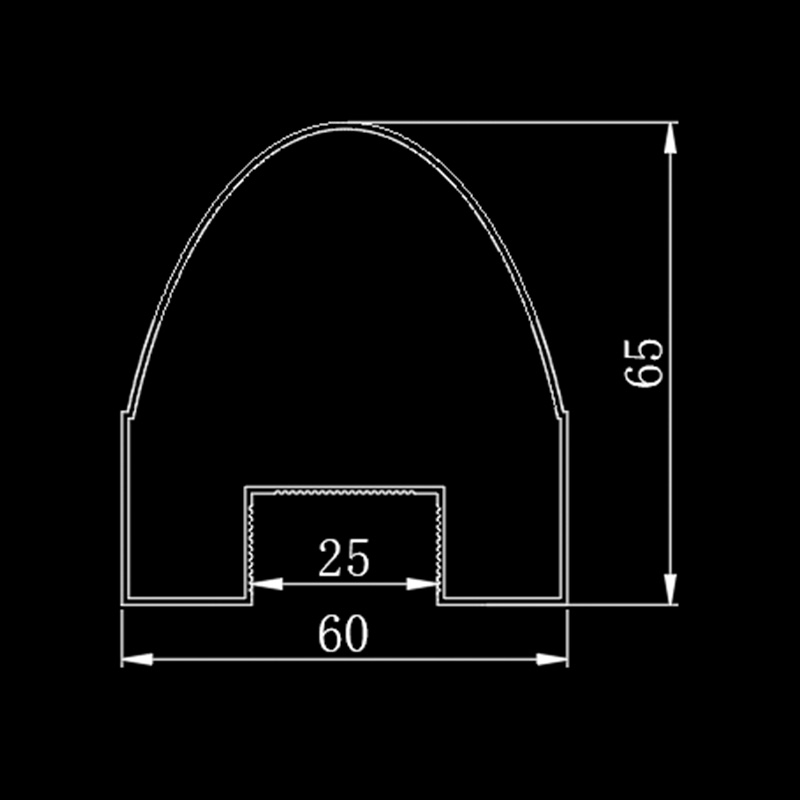The core technology of siliconized wool strips lies in the silicone oil treatment process. Silicone oil is an organic silicon compound with low surface tension and high lubricity. It is combined with wool strip fibers through an impregnation or coating process to form a stable molecular layer. This layer structure can reduce the friction coefficient between the wool strip and the profile surface to below 0.2, which is much lower than the 0.5~0.8 of traditional wool strips, thereby reducing the resistance when the window sash is opened and closed, and extending the service life of the sealing system.
The density of wool bundles is a key parameter affecting the sealing performance. The siliconized wool strips of lightweight casement window architectural aluminum profiles for light casement windows adopt the "graded density" design concept: the density of wool bundles close to the profile surface is higher (about 200 strands/cm²) to fill small gaps; the density of wool bundles far away from the profile is lower (about 100 strands/cm²) to reduce friction resistance. This gradient design not only ensures sealing, but also avoids deformation caused by excessive extrusion of wool bundles.
The elastic modulus is an important indicator for measuring the deformation recovery ability of wool strips. Siliconized wool strips control the elastic modulus in the range of 150~200MPa through the coordinated optimization of fiber material and weaving process. This range can not only meet the deformation requirements when the window sash is opened and closed, but also quickly restore the initial state after closing, ensuring the dynamic balance of the sealing gap.
Siliconized wool strips use a three-dimensional weaving process to form a three-dimensional structure similar to a "spring". Its wool bundles can deform simultaneously along the movement direction of the window sash (X-axis), vertical direction (Y-axis) and depth direction (Z-axis), thereby filling the three-dimensional gap between the window sash and the window frame. For example, when the window sash is closed, the Z-axis deformation of the wool strip can compensate for the profile processing error, the Y-axis deformation can adapt to the slight deformation of the window frame, and the X-axis deformation provides continuous sealing pressure.
In order to match the cross-sectional structure of the aluminum profile of the light casement window, the cross-sectional shape and size of the siliconized wool strip need to be customized. For example, in the insulation cavity of the insulation aluminum profile, the wool strip needs to adopt a "split" structure, which fits the inner and outer aluminum surfaces respectively; in the drainage hole area, the wool strip needs to be set with a "avoidance groove" to avoid blocking the drainage channel. This adaptability design ensures the coordinated work of the sealing system and the profile.
The siliconized wool strip does not exist independently, but together with EPDM rubber strips, sealants and other materials to form a composite sealing system. For example, at the edge of the window sash, the siliconized wool strip is responsible for filling the tiny gap, and the EPDM rubber strip bears the main sealing pressure. The two achieve dual guarantees of air tightness and water tightness through the "soft and hard combination" method.
The siliconized wool strip needs to pass more than 50,000 opening and closing cycle tests. During the test, the friction coefficient, deformation recovery rate and sealing gap change rate of the wool strip are the core evaluation indicators. For example, after 50,000 openings and closings, the friction coefficient of the wool strip should be kept below 0.25, the deformation recovery rate should be no less than 95%, and the sealing gap change rate should be less than 5%.
To verify the weather resistance of siliconized wool strips, extreme environmental tests such as high temperature (80℃), low temperature (-40℃), high humidity (95%RH) and ultraviolet irradiation are required. For example, in the ultraviolet aging test, the silicone oil layer of the wool strip should remain intact and the fiber strength attenuation rate should be less than 20%; in the high humidity test, the wool strip should be free of mildew and corrosion.
The performance of siliconized wool strips must comply with national standards such as GB/T 24498-2009 "Building Door and Window Sealing Wool Strips". In addition, international certifications such as CE certification and ASTM certification also have strict requirements on the sealing performance, environmental protection performance and safety of wool strips. For example, CE certification requires that the formaldehyde emission of wool strips be less than 0.1mg/L, and ASTM certification classifies the fire resistance of wool strips.
In high-rise buildings, the low friction coefficient of siliconized wool strips can reduce the noise and resistance when the window sash is opened and closed, and improve the comfort of use. In typhoon-prone areas, the high elastic modulus and sealing stability of wool strips can resist strong wind impact and prevent rainwater intrusion.
In passive buildings, the sealing performance of siliconized wool strips directly affects the insulation and airtightness of the building. For example, a passive house project uses high-density siliconized wool strips to reduce the heat transfer coefficient Uf value of the entire window to below 0.8W/(m²·K). In near-zero energy buildings, the long-term stability of the wool strips can reduce the maintenance cost of the sealing system.
With the development of building industrialization, siliconized wool strips are evolving towards intelligence and environmental protection. For example, the application of nano-modified silicone oil can enhance the self-repairing ability of wool strips and extend their service life; the research and development of bio-based fibers can reduce the carbon emissions of wool strips, which is in line with the concept of green buildings.

 ENG
ENG
 English
English русский
русский 中文简体
中文简体 Español
Español bahasa Indonesia
bahasa Indonesia


